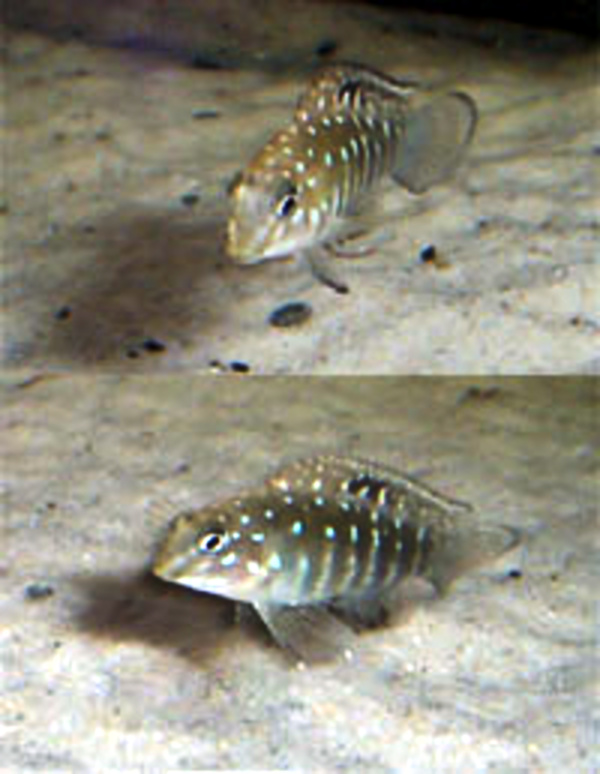Tanganicodus irsacae
| Tanganicodus irsacae | ||||||||||||
|---|---|---|---|---|---|---|---|---|---|---|---|---|

Tanganicodus irsacae |
||||||||||||
| Systematics | ||||||||||||
|
||||||||||||
| Scientific name of the genus | ||||||||||||
| Tanganicodus | ||||||||||||
| Poll , 1950 | ||||||||||||
| Scientific name of the species | ||||||||||||
| Tanganicodus irsacae | ||||||||||||
| Poll , 1950 |
Tanganicodus irsacae is an endemic species of cichlid livingon the coasts of the East African Lake Tanganyika . The genus was named after the distribution area, the scientific way epithet refers to a Belgian Research Institute ( I nstitut pour la r echerche s cientifique en A frique c connotations of core).
features
Tanganicodus irsacae becomes 7 cm long, females stay a little smaller. The body is elongated, somewhat flattened on the sides and only a little high. The head is pointed, the mouth below. Each jaw has long teeth, red at the tip ("tweezers"). The extended pectoral fins are suitable for support on the ground. The dorsal fin is very long and pointed at the soft end. The pelvic and anal fins are also pointed. The swim bladder is short. Tanganicodus irsacae has an olive-green to beige-brownish base color. The sides of the body are provided with 7 to 8 vertical light stripes, which merge into light blue spots in the upper half of the torso. The head and dorsal fin are also patterned with light blue to greenish spots. The underside of the head is whitish. The dorsal fin and the caudal fin are lined with orange at the top, the other fins are mostly brownish and dark lined.
- Fins formula : Dorsal XXIII – XXIV / 4–5, Anale III / 7
- Dandruff formula mLR 30–32, SL 22–24 / 69-10
Way of life
Tanganicodus irsacae lives close to the ground, near the coast of Lake Tanganyika, and moves in a jerky, "hopping" way of swimming. Like other representatives of the goby cichlids ( Eretmodini ), it rests on the ground with its pectoral fins. It feeds on small organisms, especially crustaceans and insect larvae, which it can peck with its long front teeth from the ground and from the algae growth on the rocks. The cichlids are monogamous and spawn on a flat stone surface or over a sandy bottom. The female then ingests the 20 or more eggs into the mouth for around 12 to 14 days. Then the mouthbrood care is passed on to the male , who carries the eggs around in his mouth for another 7 to 10 days. Once the juvenile fish have hatched, they are released from the mouth, cared for in pits in the lake floor and not taken back into the mouth.
Systematics
Genus and species were first scientifically described in 1950 by the Belgian ichthyologist Max Poll . The genus has remained monotypical so far . However, the Swedish ichthyologist Sven O. Kullander and his American colleague Tyson R. Roberts found a second Tanganicodus species that has not yet been described in the Lukuga , the outflow from Lake Tanganyika to the Congo . Within the cichlids, Tanganicodus forms the tribe Eretmodini together with the genera Eretmodus and Spathodus , which also contain two species each .
literature
- Hans Joachim Richter: Zwergbuntbarsche Neumann Verlag, Leipzig, Radebeul, ISBN 3-7402-0028-6 .
- Georg Zurlo: Tanganicodus irsacae. In: Claus Schaefer, Torsten Schröer (Hrsg.): The large lexicon of aquaristics. 2 volumes. Eugen Ulmer, Stuttgart 2004, ISBN 3-8001-7497-9 , p. 923 f.
- Günther Sterba : The world's freshwater fish. 2nd Edition. Urania, Leipzig / Jena / Berlin 1990, ISBN 3-332-00109-4 .
Individual evidence
- ^ Sven O. Kullander and Tyson R. Roberts: Out of Lake Tanganyika: endemic lake fishes inhabit rapids of the Lukuga River. Ichthyol. Explor. Freshwaters, Vol. 22, No. December 4, 2011 © 2011 by Verlag Dr. Friedrich Pfeil, Munich, Germany - ISSN 0936-9902
Web links
- Tanganicodus irsacae on Fishbase.org (English)
- Tanganicodus irsacae onthe IUCN 2013 Red List of Threatened Species . Posted by: Bigirimana, C., 2006. Retrieved September 19, 2013.